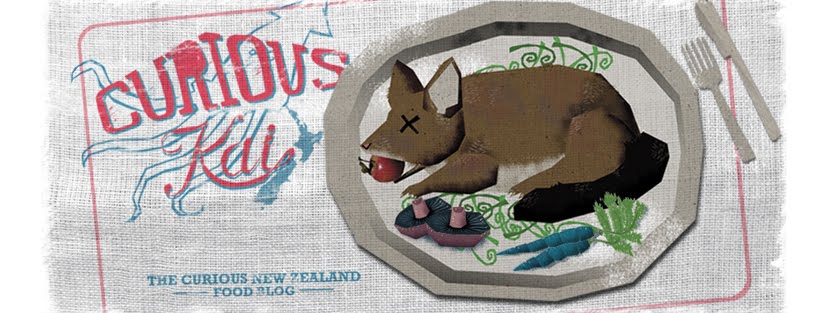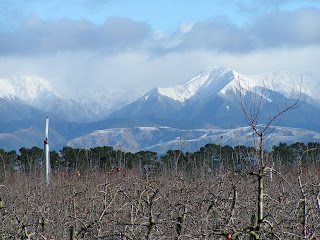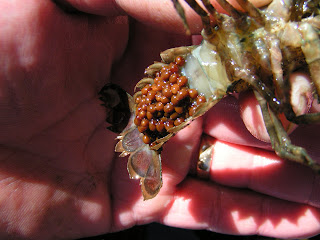Despite being two totally separate species, there are a surprising number of
similarities between the small spindly aquatic animal and the gigantic biped holding it (above). Both species enjoy swimming and are often to be found frolicking amongst rocks. Both are capable of prolific levels of breeding; both too, can become quite fiesty when backed into a corner. There however, the differences end. One of these creatures tastes delicious dipped in pesto or melted butter; the other would require an evening of extensive wining and dining before the idea could even be broached.
Let's examine the smaller of the two: say hello to Paranephrops planifrons, more commonly known as koura, or the freshwater crayfish.
Don't they look tasty! While looking rather impressive in the photo, they're actually quite small. There are two species of this endemic crustacean found in New Zealand's waterways; the North Island variety measures 70 millimetres in length and the South Island variety, 80 millimetres. Commercially farmed koura are much bigger, measuring anywhere from 120 to 150 millimetres in length.
Koura are brown-green in colour, matching the stones and riverbed of their habitat. They're active at night, spending their time scavenging and feeding, retiring to the nooks and crannies offered by river rock during the day. For sustenance, koura eat whatever floats their way (leaves, riverweed and the like) as well as consuming small insects. Koura themselves are the favoured food of eels, trout and people. Maori in particular have a long held fondness for them, considering them quite a delicacy, and for good reason too, being pleasantly sweet and succulent.
One of my earliest memories involves regular family visits to my father's favourite aunt. She lived on a farm near Norsewood which had a creek that ran through the bottom of the property. Dad would take us there and spend hours searching under rocks, filling an old kerosene tin with the bodies of these spikey, boney beasties to take home to eat. Koura frequent freshwater streams, creeks and even lakes - Gary, one of my workmates, recounted stories of how his family used to fish for them in the lakes around Rotorua. They would attach fern fronds to lengths of rope which would then be set along the lakeshore, and left for a few hours. Koura, being scavengers and opportunists, would come out and nibble on the fronds. All that was required was to lift the rope out of the water with, fingers crossed, attached (and rather surprised) koura.
Another method was to lash open-weave baskets to old broom handles. They would slowly walk through the lake shallows at night and upon sighting koura, attempt to scoop them up with the basket (open-weave was important because it would minimise drag as it was pushed through the water; not too open, mind - you didn't want your prey to fall out either). Once it was scooped up, it was deposited into a container floating in the water behind the hunter, attached to their leg with a piece of cord.
All these tales of freshwater crayfish were beginning to stir both my curiosity and my appetite. Kerry Grant - friend, workmate and long standing 'wild food' consultant for Curious Kai – expressed an interest in gathering some and happened to have friends with a stream running through their farm. With relatively settled weather gracing the Ruahine Ranges, the rivers and streams below would be quite clear and clean, giving us a good chance of finding koura. So with that, off we went on our spur of the moment adventure.
We presently arrived at Kim and Jackie's farm in the early part of the afternoon. The stream itself was located just a stone's throw from the farmhouse in a small gully. It was idyllic; sun-dappled leaves, birdsong, the murmur of the flowing stream. All that was needed to complete the scene were a few characters from a Jane Austen novel, picnicing in the sun, drinking tea, bosoms covered in shortbread crumbs.
Enough shortbread - time to get to work! Finding koura is as simple as lifting rocks. They tend to shelter well away from the main force of the current, so look amongst rocks and stones near shore, but still in the water. If you don't find anything, be sure to place the rocks you lifted back where you found them. If you happen to come upon a koura, well done!
Now, keep your movements to a minimum and watch where your shadow lies – their home has been compromised so they're now on full alert. The water is doubtlessly murky, unavoidable given you had to move a rock or two. Allow it to settle before making the next move, and bear in mind that the koura could well use this opportunity to leg it. However, it may instead choose to stay, employing its camouflage to evade capture. Sight the koura, and then slowly ease your hand into the water behind the creature, placing it over the vicinity of the body and behind the pincers. Once positioned, lance down and grab it! It will thrash around but don't worry, it's tiny and won't hurt you. Don't however, under-estimate the power of its pincers. They won't break skin, but it'll be alarming enough to make you drop it. Well done on making your first catch!
By the way, if you plan on spending any considerable length of time catching koura, take an insulated bag and some ice to keep your catch fresh.
The stream was home to a wealth of food – over the course of the afternoon, we came across watercress, eels, trout, ducks and a small dog (it wasn't particularly meaty, so we threw it back).
We found a pregnant female. Depending on her size, a female can harbour as many as up to 200 eggs. The resulting young are 1-2 millimetres in length and cling to the mother until they are 4 millimetres long. Adulthood is achieved in their fourth year, by which stage they're about 20 millimetres in length. Back in the stream you go...
After about four hours, we retired with a dozen koura – enough to feed, er, one hungry person (two, if that person had the good grace to share).
Arriving back at Kerry's, it was now time for some cooking. They're the easiest thing to take care of: simply place a large pot of water on to boil, and then add your koura - they'll immediately change colour, turning a fantastic bright orange. Leave for a couple of minutes to cook (at the most), remove and then eat immediately, as we did.
What else could you do with koura? Given their size, I'd treat them as you would prawns. Removing the shells, you could marinate them raw in olive oil, garlic and paprika, or pear nectar and grated ginger before grilling them. You could also mince some garlic and fry with some chopped chillis before adding bias-cut asparagus and a half dozen or so shelled koura. Once cooked, throw it all into a bowl with some cannellini beans, rocket, salt, cracked pepper & a little lemon juice – lunch up! You could even consider making a bisque, if you were wanting something elaborate. I haven't made bisque since school, so that would be an interesting project...
Here's Kerry and his son, Job, laying waste to the day's catch! As I mentioned earlier, they have a pleasantly sweet flavour, and are quite juicy and succulent, although it's barely a mouthful. The legs are not worth bothering with unless it's a particularly large animal, but waste not, want not.
Looking for koura is a perfect way of spending a warm afternoon fossicking down at the river, either with friends or with your children (country kids have been doing this for decades). It's also a chance to become acquainted with your local flora and fauna; grab a field guide from your local public library and use it to examine your surroundings – you'll be amazed at what you find...
Please remember that there is a catch limit, set at a maximum of fifty koura per day; it's also illegal to sell or trade koura.
A very big thank you to Kerry, and also to Kim and Jackie Lowry for letting us loose on their amazing farm.
Links:
More information on koura, courtesy of DOC: cerlickety
My favourite guide to NZ plants and fungi: cerlickety




















6 comments:
Awesome, I miss New Zealand and love foraging for food.Got a sweet potato bread starter going thanks to your Rewena post.
Cheers
Go the All Whites
No worries, Barton - glad to be of service.
Dammit, I've deleted the shot of the flesh. I should have made a bisque, too. If this weather clears, I'll go back out & round up some more.
Kia ora Nigel,
Growing up in Wisconsin we always hunted local creeks for crawdads or crayfish. Catching them was great fun, and took a bit of practice as they swam backwards very fast if they sensed you coming. And a boil up was a tasty treat. A lot of the local taverns sold them cooked by the bagful and I remember my dad quite a few times sitting down with a cold lager a bagful of craw dads and a few cold lagers. Great memories, might have to give it a try here now that I am a bit more mobile. Have a great weekend.
Cheers,
Robb
We called them yabbies where I'm from (country Victoria, Australia). We also quite happily spent entire weeks of school holidays searching for them and making traps in the creeks.
Might have to get back into it as an adult in NZ! Yum!
Robb - Good to hear from you! That sounds idyllic - lagers & crawdads; the sort of thing you'd indulge in on a hot summers afternoon, having spent the morning hunting for them. I can see this becoming a regular happening, once it's warmer.
Kat - Yep, yabbies, crawdads, koura - no matter what you call 'em, they're tasty!
Post a Comment